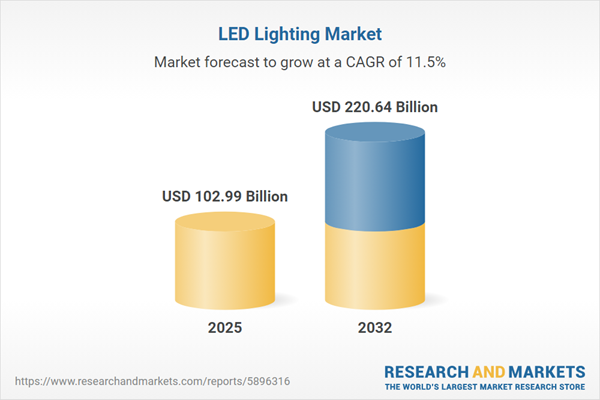Speak directly to the analyst to clarify any post sales queries you may have.
The LED lighting market is evolving rapidly, fueled by ongoing technological advancements, regulatory shifts, and sustainability priorities. Senior decision-makers need strategic clarity on where growth, risk, and transformation opportunities lie.
Market Snapshot: The LED Lighting Market’s Current Trajectory
The global LED lighting market grew from USD 92.44 billion in 2024 to USD 102.99 billion in 2025. It is projected to maintain strong momentum with a compound annual growth rate (CAGR) of 11.48%, reaching USD 220.64 billion by 2032. These figures underscore robust, multi-regional expansion as businesses, cities, and consumers continue to seek energy-efficient and connected lighting solutions. Manufacturers, distributors, and end users operate in a highly dynamic environment where competitive positioning is strongly influenced by technology, supply chain resilience, and regulatory compliance.
Scope & Segmentation: Breadth Across Applications, End Users, and Technologies
This LED lighting market report offers detailed insights into every segment and sub-segment shaping global and regional trends:
- Product Types: Drivers—Constant Current Drivers, Constant Voltage Drivers, Programmable Drivers; Lamps—Bulbs, Spotlights, Tubes; Luminaires—Downlights, Flood Lights, Panels, Street Lights.
- Applications: Indoor (Commercial, Hospitality, Industrial, Residential); Outdoor (Landscape, Sports Lighting, Street Lighting).
- End Users: Commercial (Education, Healthcare, Hospitality, Office, Retail), Industrial (Manufacturing, Mining, Warehousing), Institutional (Educational, Government, Healthcare), Residential (Multi Family, Single Family).
- Distribution Channels: Offline (Distributors, Retailers, Wholesalers), Online (Direct Sales, E Marketplaces).
- Mounting Types: Pendant, Recessed, Surface Mount, Track configurations.
- Technology Platforms: COB, High Power, Mid Power, SMD diodes.
- Regions: Americas (United States, Canada, Mexico, Brazil, Argentina, Chile, Colombia, Peru), Europe, Middle East & Africa (United Kingdom, Germany, France, Russia, Italy, Spain, Netherlands, Sweden, Poland, Switzerland, UAE, Saudi Arabia, Qatar, Turkey, Israel, South Africa, Nigeria, Egypt, Kenya), Asia-Pacific (China, India, Japan, Australia, South Korea, Indonesia, Thailand, Malaysia, Singapore, Taiwan).
- Key Companies Analyzed: Signify N.V., Nichia Corporation, OSRAM GmbH, Acuity Brands, Inc., Seoul Semiconductor Co., Ltd., Zumtobel Group AG, Panasonic Holdings Corporation, Eaton Corporation plc, Current Lighting Solutions LLC, Dongguan Leedarson Lighting Co., Ltd.
Key Takeaways: Strategic Insights for Senior Leaders
- Sustainability imperatives are steering procurement decisions, from material sourcing to end-of-life recycling, creating new opportunities for manufacturers implementing circular economy principles.
- Disruptive innovations such as programmable LED drivers and modular system architectures continue to differentiate market offerings, supporting adaptive lighting environments and human-centric design.
- Emerging partnerships across the value chain are closing lifecycle loops and driving environmental accountability, while supply chain agility is now a critical competitive factor.
- Regional dynamics present varied regulatory and adoption drivers, from smart infrastructure and urbanization in Asia-Pacific to retrofit incentives in the Americas, requiring tailored go-to-market strategies.
- Manufacturers optimizing analytics, service agreements, and upgrade pathways are better positioned to capture repeat business and justify premium offerings, despite ongoing pricing pressures.
Tariff Impact: Navigating the Changing U.S. Trade Environment
Newly imposed tariffs in the United States are prompting re-evaluation of supply chains, inflating input costs, and affecting pricing strategies. These measures encourage nearshoring, diversification of supplier bases, and increased focus on total cost of ownership, prompting both private and public buyers to scrutinize lifecycle value more closely.
Methodology & Data Sources: Robust Validation and Industry Expertise
This study integrates primary research through interviews with executives, R&D leaders, and procurement teams, alongside in-depth secondary research from academic, regulatory, and industry sources. Triangulation and analytical frameworks such as SWOT and PESTEL ensure consistency, accuracy, and credible projections for the LED lighting market outlook.
Why This Report Matters: Actionable Value for Senior Decision-Makers
- Delivers actionable insights on product innovation and market entry strategies to fortify positioning.
- Enables informed, data-driven decisions for geographic expansion, partnership selection, and operational risk mitigation.
- Provides a clear roadmap to harness regional growth, sustainable practices, and shifting regulatory landscapes for revenue impact.
Conclusion
The LED lighting market’s evolution presents both challenges and actionable growth pathways. Strategic focus on technology, sustainability, and supply chain resilience will be paramount for continued success.
Additional Product Information:
- Purchase of this report includes 1 year online access with quarterly updates.
- This report can be updated on request. Please contact our Customer Experience team using the Ask a Question widget on our website.
Table of Contents
3. Executive Summary
4. Market Overview
7. Cumulative Impact of Artificial Intelligence 2025
Companies Mentioned
The companies profiled in this LED Lighting market report include:- Signify N.V.
- Nichia Corporation
- OSRAM GmbH
- Acuity Brands, Inc.
- Seoul Semiconductor Co., Ltd.
- Zumtobel Group AG
- Panasonic Holdings Corporation
- Eaton Corporation plc
- Current Lighting Solutions LLC
- Dongguan Leedarson Lighting Co., Ltd.
Table Information
| Report Attribute | Details |
|---|---|
| No. of Pages | 199 |
| Published | October 2025 |
| Forecast Period | 2025 - 2032 |
| Estimated Market Value ( USD | $ 102.99 Billion |
| Forecasted Market Value ( USD | $ 220.64 Billion |
| Compound Annual Growth Rate | 11.4% |
| Regions Covered | Global |
| No. of Companies Mentioned | 11 |









